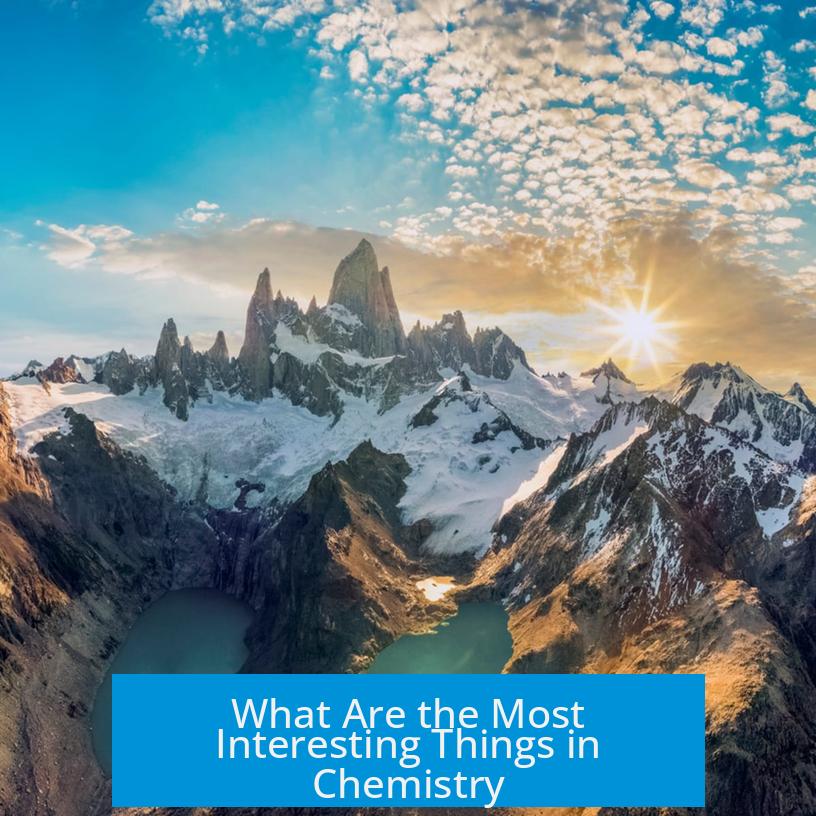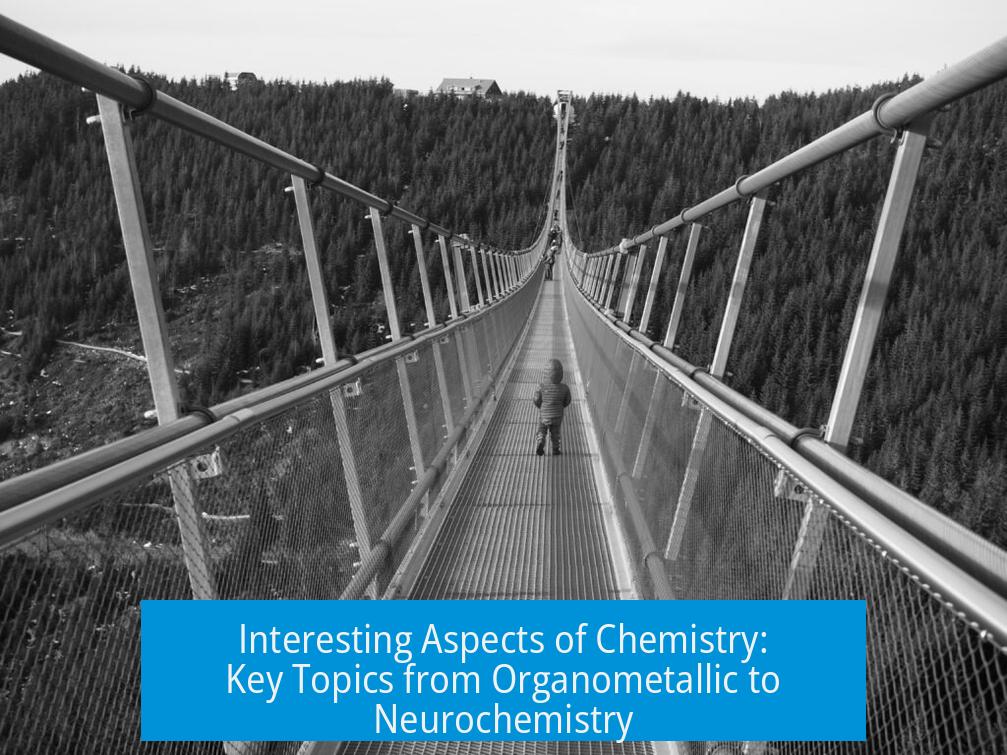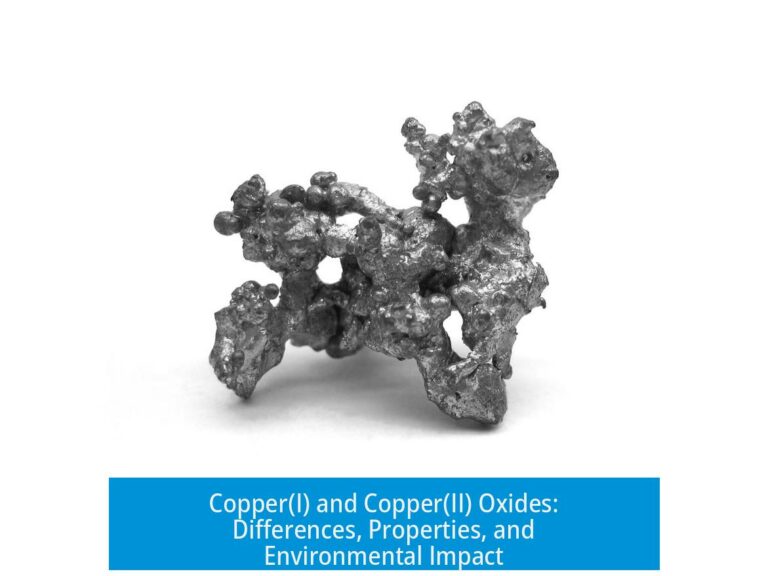What Are the Most Interesting Things in Chemistry?

Chemistry offers a vast array of fascinating fields, each unraveling different aspects of matter and its transformations. Among the many areas, several stand out for their scientific intrigue, practical applications, and conceptual depth. These include organometallic photophysics, organic synthesis, quantum mechanics in chemistry, pharmacology related to plants, and advanced materials like Metal Organic Frameworks.
1. Organometallic Chemistry and Photophysics
Organometallic chemistry explores compounds featuring metal-carbon bonds. Within this realm, organometallic luminophores display unique photophysical properties. These molecules emit light when excited, critical in developing new lighting technologies and sensors.
Photophysics and photochemistry study how light interacts with molecules. This multidisciplinary area explains energy transfer, fluorescence, and photochemical reactions. The insights enable innovations in solar energy conversion and photodynamic therapies.
2. Organic Synthesis
Organic synthesis involves constructing complex organic molecules from simpler substances. This field is central to producing pharmaceuticals, agrochemicals, and materials. Many chemists find organic synthesis compelling due to the creativity and precision it demands, akin to molecular engineering.
The challenges encountered in organic synthesis courses reflect the complexity of designing reaction pathways, making it a favorite subject. Synthesizing molecules offers a hands-on route to understand chemical reactivity and make new compounds tailored for specific functions.
3. Quantum Mechanics in Chemistry
Quantum mechanics forms the foundation of modern chemistry. It explains why elements behave as they do, why gold appears yellow and mercury is liquid at room temperature, and why some isotopes are stable while others decay.
At the molecular and atomic levels, quantum theory describes electronic structures and bonding. This approach extends into quantum biology, proposing quantum effects influence biological processes. For example, tautomerism linked to genetic mutations may be explained through quantum phenomena.
The integration of quantum mechanics elucidates chemical properties from fundamental principles, providing a deep understanding of matter’s behavior.
4. Pharmacology and Plant Biology
Pharmacology and plant biology intersect interestingly. Many drugs derive from plant metabolites synthesized through enzymatic pathways. Examples include caffeine, nicotine, ephedrine, and salicylic acid.
Studying how plants manufacture these bioactive molecules reveals nature’s chemical ingenuity. These insights guide drug discovery and synthetic biology, fostering new therapeutics inspired by natural products.
5. Metal Organic Frameworks (MOFs) and Catalysis
Metal Organic Frameworks (MOFs) are porous, crystalline materials formed by metal ions coordinated to organic linkers. MOFs’ modular structure allows tailoring properties for selective catalysis, gas storage, and sensing applications.
The chemistry community shows intense interest in MOFs due to their catalytic capabilities and adaptability. Related materials like zeolites share similar features. Research focuses on optimizing these frameworks for environmental and industrial processes.
6. Spectroscopy and Chromatography Techniques
Spectroscopy enables the analysis of matter by examining how it interacts with electromagnetic radiation. Techniques such as UV-Vis, IR, and NMR spectroscopy provide molecular fingerprints for identification and structural analysis.
Chromatography separates chemical mixtures based on component interactions with stationary and mobile phases. It is essential for purifying compounds and analyzing complex mixtures in pharmaceuticals, environmental samples, and materials science.
7. Polymer Chemistry and Structure-Property Relationship
Polymer chemistry studies large macromolecules made from repeating units. Understanding how polymer structure influences material properties enables designing plastics, fibers, and coatings with desired mechanical and thermal characteristics.
This hands-on area highlights the connection between molecular architecture and real-world applications, making polymers vital to modern technologies.
8. Photon Mediated Chemistry
Photon mediated chemistry involves reactions influenced or driven by light. Photo-redox chemistry, photo-catalysis, and surface plasmon resonance are examples.
These processes harness light energy for chemical transformations with increased selectivity and energy efficiency. Advances in this field open avenues for sustainable synthesis and solar fuel generation.
9. Neurochemistry and Psychopharmacology
Neurochemistry explores chemical processes in the nervous system. Psychopharmacology studies how drugs affect brain chemistry to alter perception, mood, and behavior.
Understanding how neurotransmitters and receptor ligands function provides insights into brain activity, consciousness, and treatment of neurological disorders.
10. Deconstruction and Reconstruction of Matter
Chemistry fundamentally deals with breaking down substances into atoms and molecules and rebuilding them into new forms. This concept encapsulates the essence of chemical transformation and design.
By manipulating matter at the smallest scale, chemists create novel compounds and materials with tailored functions. This process exemplifies human intellect’s power and creativity.
Additional Fascinating Topics
- Atomic and molecular basis of matter: Everything stems from atoms and their arrangements.
- Macro-level effects and colloids: Studying how nanoscale interactions produce bulk properties.
- Unique molecules: For example, arsole—a ring molecule incorporating arsenic—illustrates chemical diversity.
- Laboratory techniques: Electrochemistry fascinates with visible effects, while chromatography columns may not appeal to all.
Key Takeaways
- Chemistry spans diverse fields from organometallic photophysics to quantum biology, each uncovering unique chemical phenomena.
- Organic synthesis challenges the chemist to build complex molecules, fueling pharmaceuticals and materials development.
- Quantum mechanics underpins chemical behavior and explains elemental and molecular properties.
- Plant pharmacology connects natural biosynthesis with drug discovery.
- Metal Organic Frameworks represent a cutting-edge area of catalysis and materials science.
- Spectroscopy and chromatography provide essential tools for chemical analysis.
- Photon mediated reactions and neurochemistry expand the frontiers of sustainable chemistry and biology.
- Investigating atomic arrangements reveals the foundations of the material world.
What makes organometallic luminophores interesting in chemistry?
Organometallic luminophores combine metal atoms with organic molecules to emit light. They link photophysics and photochemistry, revealing how molecules absorb and release energy as light.
Why is quantum mechanics essential in understanding chemistry?
Quantum mechanics explains why atoms and molecules have certain properties. It clarifies why gold is yellow, mercury is liquid, and why some atoms are stable while others are not.
How does organic synthesis capture chemists’ interest?
Organic synthesis involves constructing complex molecules from simpler ones. It challenges chemical intuition and builds the foundation for material science and drug development.
What role do Metal Organic Frameworks (MOFs) play in modern chemistry?
MOFs can be tailored for specific catalytic tasks. They are a hot research area due to their customizable structures and wide applications, including catalysis and gas storage.
Why is pharmacology linked with plant biology in chemistry?
Many drugs come from plant compounds. Chemistry studies enzymatic pathways in plants that produce caffeine, nicotine, and other bioactive molecules, helping understand and create pharmaceuticals.
What makes photon mediated chemistry a significant topic?
Photon-mediated chemistry includes photo-redox reactions and catalysis powered by light. It explores how light energy triggers chemical changes, impacting fields like solar energy and catalysis.





Leave a Comment